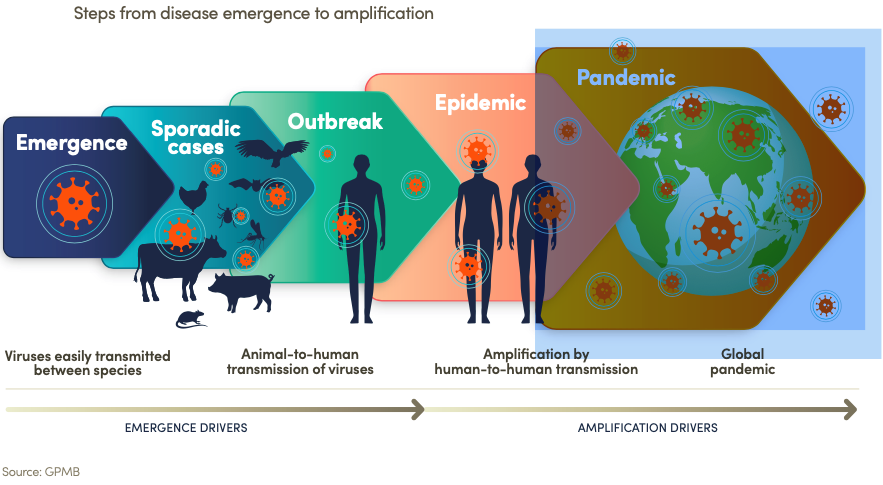
Berlin: New risks raise pandemic threat on a global scale! In 2024 alone, 17 outbreaks of dangerous diseases have already occurred. Each new outbreak exposes fault lines in the existing pandemic prevention architecture and global readiness to respond to disease outbreaks.
Epidemics and pandemics are now a constant danger rather than rare events.
Outbreaks of avian influenza H5N1 in cattle and its spillover to humans, and a new strain of mpox in Central Africa are the most recent signals of concern. Along with them, recent outbreaks of the Marburg virus too are a stark reminder of the world’s vulnerability to pandemics. The high likelihood that they will spread further should be a wake-up call for the global community.
The 21st century has seen a significant rise in global health threats due to increasing human interconnectedness and mobility, which facilitate the rapid transmission and geographic spread of epidemic diseases.
Already this century a series of outbreaks has underscored the world’s vulnerability to epidemics and pandemics, including SARS, MERS, the 2009 influenza pandemic, Ebola in West Africa, yellow fever in Angola and the DRC, cholera, Zika, plague, COVID-19 and mpox, along with the continuing prevalence of HIV/AIDS. These outbreaks have demonstrated that the 1960s optimism that wealth and antibiotics would eradicate infectious disease in all but the poorest countries was sadly misguided.
A plethora of risks increase the likelihood of new pandemics according to a new report from the Global Preparedness Monitoring Board (GPMB), an independent monitoring and accountability body to ensure preparedness for global health crises. The report, launched at the 15th World Health Summit in Berlin today, outlines 15 key drivers of pandemic risk, categorized into five distinct groups: social, technological, environmental, economic, and political.
GPMB, an initiative supported by the World Health Organization and the World Bank, tracks the drivers of pandemic risk and oversees global preparedness. According to the report, the next pandemic will be different from the last, therefore responses must be adaptable to changing local, national and global contexts. It warns that many pandemic risks cannot be easily or rapidly mitigated, and hence, countries need increased protection.
The report stresses the urgency of understanding the global vulnerability to threats and calls for a radical reset of the collective approach to pandemic preparedness.
In the 21st century, epidemics are more likely to occur, spread more rapidly and have a higher impact on a globalized economy. The report calls upon the countries to be prepared to face multiple concurrent epidemics, requiring national and international planning and preparedness for protracted epidemics, and sustained responses.
“The global community must invest in equity, trust building, and collaboration to ensure effective responses to future health crises,” it stresses.
Lack of trust between and within countries, inequity, intensive farming and the likelihood of human-to-animal crossover are among the key threats outlined in the report. The report also identifies new risks outside of the traditional health factors.
Digital connectivity has enabled scientists to quickly sequence and share pathogen data and tailor responses ever faster. However, this digital footprint leaves health systems and societies exposed. Cyber attacks, heightened biosecurity threats, and the rapid spread of misinformation all increase the risk of a pandemic.
“The next pandemic won’t wait for us to perfect our systems,” said Joy Phumaphi, GPMB Co-Chair and former Minister of Health to Botswana. “We must invest now in resilient and equitable primary healthcare systems to withstand the challenges of tomorrow.”
The report identifies the complex and interdependent factors which shape the risk of pandemics. However, it also stresses that willingness to build flexibility into the response, proactively protect society and invest in collaborative efforts can significantly reduce risk and enhance preparedness.
To effectively protect themselves, all nations must strengthen their health systems, prioritize social protection, and ensure that essential health services are available to all communities, particularly the most vulnerable and disadvantaged. GDP alone is no measure of resilience to a pandemic.
Preparedness should incorporate strategies spanning across the human, animal, and environmental health interfaces. The report calls for increased collaboration across sectors to mitigate risks associated with pandemics, recognizing that the health of one sector is intricately linked to the health of others.
“We have a narrow window of opportunity to rethink global preparedness: to assess risks that extend well beyond the health sector, and to address some of these far more proactively, in a way that is adapted to each context,” said Kolinda Grabar-Kitarović, GPMB Co-Chair and former President of Croatia. “Vigilance, adaptability and collaboration must define our preparation now, so that is it baked-in to the response”.
The report provides a framework for policymakers to adapt existing health strategies and enhance protective measures against future pandemics. This includes ensuring prevention and response plans are regularly reviewed and flexible enough to respond to all situations. The next pandemic will not follow the same path as COVID-19, lessons learned from that experience should guide but not define preparedness.
Resilience in future health emergencies is contingent on investment in research and development, improved technology, equitable health infrastructure and an enhanced understanding of the dynamic nature of all pandemic risk drivers. In today’s interconnected world, the global community must take collective responsibility for prevention and response to disease, rather than considering preparedness as an individual country or sector-level activity.
– global bihari bureau





